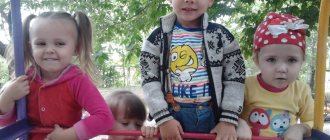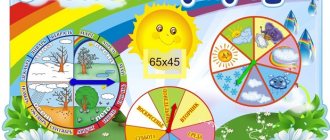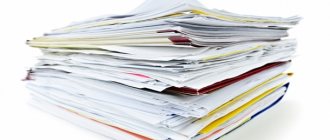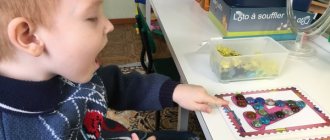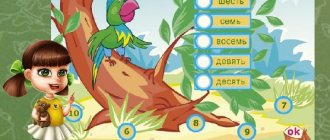Why does a child need a route and how is it compiled?
Young children with mental or physical developmental disabilities need additional help, especially with regard to socialization and education. They can receive a disability status before even entering kindergarten. Once doctors can assess intellectual level and physical development, they will determine the presence of abnormalities.
Sometimes the diagnosis is already made from birth, but some diseases can only be seen after the baby is old enough to see the discrepancy between its development and age. For example, autism or mental retardation. As soon as a deviation from the norm is determined, if it falls under the HIA categories, a special commission will propose to formalize this status. It is used to a greater extent precisely to determine the methods and education system.
An individual route takes into account absolutely all the characteristics of the child:
- disease;
- state of the art;
- influence of surrounding factors;
- mental condition;
- possible goals;
- desire to learn;
- family influence on child development;
- contact and sociality;
- presence of genetic diseases.
Absolutely every person from the child’s environment, as well as the environment, family relationships, all this affects the psyche and perception of the world around him. Therefore, when drawing up a program, teachers set goals and try to achieve them with the child. It describes each step in as much detail as possible within a certain period. At the same time, these are not only educational tasks; to increase the intellectual level, attention is also paid to the ability to communicate, make friends, and build relationships.
Speech therapy correction work as an integral component of the IOM of a child with disabilities
Speech therapy correction forms the basis of teaching a child with disabilities. Without eliminating problems in speech development, it is impossible to achieve the desired effect in the overall development of the child.
Speech therapy correction of speech disorders in a child with disabilities, included in the IOM plan, is implemented in the following areas of work:
- Establishment of articulatory motor skills. It is planned to conduct articulatory gymnastics, various exercises for the development of articulation organs;
- Development of sound pronunciation. It involves setting vowel and consonant sounds, practicing and consolidating them, followed by pronunciation training;
- Development of phonemic hearing. Children are taught to perceive objects by sounds, i.e. identify an object with a specific sound;
- Formation of the syllabic structure of a word. Here, one gets acquainted with the dictionary, sets the pronunciation of individual syllables, uses exercises to compose words from syllables, break words into syllables, etc.;
- Expansion of vocabulary. The passive dictionary is expanded and new words are included in the active dictionary;
- Formation of grammatical structures. The training program includes exercises to develop skills in identifying the characteristics of objects, their purpose, replacing words with diminutives, coordinating nouns with other parts of speech, and correctly expressing the spatial relationship of objects;
- Development of coherent speech. Children learn to coordinate nouns with adjectives, correctly express their thoughts, make requests, express desires and feelings;
- Development of the psychological basis of speech pronunciation. Work is being carried out in the direction of expanding the volume of visual memory and the ability to group objects according to similar characteristics.
The main goals of creating the IOM?
The main goal of design is the selection of a personal development system. Main tasks:
- development of a personal development program;
- creating a curriculum based on health issues;
- preparing the student for introduction into the social environment.
No one is forcing parents to switch to an individual route. The more differentiated the program is, taking into account absolutely all the features of development and environment, the greater the likelihood that in the future he will be able to become a full member of society. Loss of dependence on family and parents is another goal that the state pursues when trying to help families raising children with special needs.
Individual educational route for whom?
Drawing up an individual development route begins with studying the medical history and the parents’ decision that their child will study according to an individual program. After consent is received, the commission will discuss all the features of the program and formalize it properly. IOM is used for the most effective learning of a child. It is created jointly with a psychologist, attending physician and parents. This is a course of action designed to complement the individual curriculum.
There is one peculiarity: an individual educational route and an individual educational program are not legally approved documents, unlike an individual curriculum. By law, they are only advisory in nature, but recently programs have been actively developed in order to individualize the learning process as much as possible. This way the student will better perceive the world around him and educational information. In the first years of life, the route is drawn up in order to have a clearly developed plan of action.
Stages of developing an individual educational development route
In order to create a route, a teacher, psychologist and doctor working with a child:
- determine the level of mental development;
- the impact of the disease on educational progress;
- goals and methods for achieving them are calculated;
- the time to achieve them is determined;
- developing a plan;
- determining the method for assessing the results achieved.
Such careful work is carried out in order not to harm the fragile psyche. Since often in case of serious errors it will not be possible to try again.
Development and implementation of an individual educational route for preschoolers with disabilities
Development and implementation of an individual educational route for a preschooler
In practice, the process of training and education is mainly focused on the average level of development of the child, therefore not every student can fully realize their potential. This poses the task for educators, speech therapists, and psychologists of preschool educational institutions to create optimal conditions for the realization of the potential capabilities of each pupil. One of the solutions in this situation is the preparation and implementation of an individual educational route (hereinafter referred to as IOM).
An individual educational route is a personal way to realize the personal potential of a child (pupil) in education and training.
The main goal of drawing up an individual educational route (IER):
This is the creation in kindergarten of conditions conducive to the positive socialization of preschool children and their social and personal development.
Tasks for the social and personal development of the child:
• Create a favorable subject-development environment for the child’s social development;
• Organize a unified system of work for the administration, teaching staff, medical staff of preschool educational institutions and parents on the social and personal development of the child;
• Improve the style of communication between the teacher and the child: adhere to a psychologically correct style of communication, achieve the respect and trust of the student;
• Create conditions for the development of a child’s positive attitude towards himself, other people, the world around him, and the communicative and social competence of children;
• Develop in the child a sense of self-esteem, awareness of his rights and freedoms (the right to have his own opinion, choose friends, toys, activities, have personal belongings, use personal time at his own discretion)
The individual educational route is determined by:
government order;
the needs and requests of parents;
individual functional capabilities and level of development of pupils;
possibilities of the preschool educational institution;
Individual educational routes are developed:
— for children who do not master the basic general education program of preschool education;
- for children with disabilities, disabled children.
-for children with high intellectual development.
An individual educational route includes the main directions:
• development of general and fine motor skills;
• development of cultural-hygienic and communicative-social skills;
• formation of the child’s activities (manipulative, sensory-perceptual, objective-practical, playful, productive), which include modeling, appliqué, drawing) and other types of productive activities.
• development of speech (formation of the sensory basis of speech, sensorimotor mechanism, speech functions);
• formation of ideas about the environment (the objective world and social relations);
• formation of ideas about space, time
Methods used in the work:
• Conversations, games, activities, reading fiction, sketches aimed at getting to know various emotions and feelings, with “magic” means of understanding;
• Games, exercises and trainings that promote the development of emotional, personal and behavioral spheres (developing communication skills and improving relationships with others, relieving fears and increasing self-confidence, reducing aggression and weakening negative emotions)
• Activities, games and exercises for the development of mental processes (memory, attention, perception, thinking, imagination);
• Art therapy techniques (puppet therapy, isotherapy, fairy tale therapy);
• Relaxation psycho-gymnastic exercises (relaxation of the muscles of the face, neck, torso, arms, legs, etc.)
When developing an individual route, we rely on the following principles:
- the principle of relying on the child’s learning ability,
— the principle of correlating the level of current development and the zone of proximal development.
- the principle of respecting the interests of the child. Another name for it is “on the child’s side.” Those educators must treat the child and his problems objectively! Always be on the child's side!
— the principle of close interaction and coordination of the work of a “team” of specialists in the course of studying the level of development of a child (phenomenon, situation);
— the principle of continuity, when the child is guaranteed continuous support at all stages of assistance in solving the problem.
— the principle of rejecting average rationing. The implementation of this principle involves avoiding a direct evaluative approach when conducting a diagnostic examination of the child’s level of development.
— the principle of relying on children's subculture. Each child, enriching himself with traditions, norms and methods developed by the children's community, lives a full-fledged childhood experience.
Based on the analysis of the literature we studied, several stages of constructing an individual educational route were identified
Approximate diagrams of IOM for preschoolers of the 1st junior group
Child's name: Misha
Age: 2 years
Group: 1st junior
Difficulties: Lag in speech development, problems with communication.
| Month A week | Regime moments | Didactic games, direct educational activities | Joint activities with a teacher | Interaction with parents |
| August 1 Week | Order: Help the teacher choose a book to read | Working with salted dough "Octopus" | Go out with the teacher to the reception area and find your locker | Finger gymnastics “My Family” |
| 2 week | Instructed to: Find your own shoes in the reception area before your walk. | Did. Game “Who Screams How” | Help the teacher count the children and note who is absent | Recommend to parents a list of games for speech development |
| 3 week | Name the items needed for GCD drawing. | Palm drawing “Funny octopuses” | Finger game "Hide and Seek" | |
| 4 week | Prepare yourself for bed and find your crib | Did. Game “Who Screams How” | Exercise for the articulatory apparatus “The bubble burst”, “The bunny was mistaken for a wolf” | Exercise for the articulatory apparatus “The bubble burst” |
| September 1 Week | Walk “What has changed on the site” | Presentation about animals "Who's Who" | Exercise “Show how a kitten laps milk” | Game "Visit us." |
| 2 week | Put the scattered toys back in their places. | Learning the poem by A. Barto “Dropped the bear on the floor” using facial and body expressions | Communication game “Tender Name” | Repeating a poem learned in kindergarten... |
| 3 week | Reciting A. Barto’s poem “Our Tanya is crying loudly” in front of the whole group | Ex. For lips “Needle” | Finger gymnastics “Cabbage” | |
| 4 week | Tidy up the drawing corner | Working with visual material "What is missing?" | Did. Game "Buttons and Bows" | Game for attention "What is missing?" |
| October 1 Week | Learn to collect toys while walking | Finger painting “Tender sun” | Did. Sensory game “Wonderful bag” | Consultation for parents “Child’s adaptation in kindergarten” |
| 2 week | Finger gymnastics “Fingers” | Articulation gymnastics “Frog” | Consultation “Correct speech of parents both in the family and outside the home” | |
| 3 week | Tour of the kindergarten | Drawing “Flowers” (tamponing) | Did. Game "Toys" | Let’s draw together “Mom, Dad, I am a friendly family” |
| 4 week | We use cutlery correctly: we learn to hold a spoon correctly. | Did. Game “Profession”, Articulation gymnastics “Proboscis” | Plasticineography “Tender Sun” |
Expected result
1. Development of fine motor skills of the fingers.
2. Improving the child’s oral speech, the ability to pronounce words correctly.
3. Development of communication skills.
4. Development of sensory perception of the surrounding world.
Individual development route
Child's full name: Aksinya
Age: 2.5 years
Group: 1st junior
Difficulties: Speech delays, communication problems
| Month A week | Regime moments | Didactic games, direct educational activities | Joint activities with a teacher | Interaction with parents |
| August 1 Week | Order: Help the teacher choose a book to read | Working with salted dough "Octopus" | Go out with the teacher to the reception area and find your locker | Finger gymnastics “My Family” |
| 2 week | Instructed to: Find your own shoes in the reception area before your walk. | Did. Game “Who Screams How” | Help the teacher count the children and note who is absent | Recommend to parents a list of games for speech development |
| 3 week | Name the items needed for GCD drawing. | Palm drawing “Funny octopuses” | Finger game "Hide and Seek" | |
| 4 week | Prepare yourself for bed and find your crib | Did. Game “Who Screams How” | Exercise for the articulatory apparatus “The bubble burst”, “The bunny was mistaken for a wolf” | Exercise for the articulatory apparatus “The bubble burst” |
| September 1 Week | Walk “What has changed on the site” | Presentation about animals "Who's Who" | Exercise “Show how a kitten laps milk” | Game "Visit us." |
| 2 week | Put the scattered toys back in their places. | Learning the poem by A. Barto “Dropped the bear on the floor” using facial and body expressions | Communication game “Tender Name” | Repeating a poem learned in kindergarten... |
| 3 week | Reciting A. Barto’s poem “Our Tanya is crying loudly” in front of the whole group | Ex. For lips “Needle” | Finger gymnastics “Cabbage” | |
| 4 week | Tidy up the drawing corner | Working with visual material "What is missing?" | Did. Game "Buttons and Bows" | Game for attention "What is missing?" |
| October 1 Week | Learn to collect toys while walking | Finger painting “Tender sun” | Did. Sensory game “Wonderful bag” | Consultation for parents “Child’s adaptation in kindergarten” |
| 2 week | Finger gymnastics “Fingers” | Articulation gymnastics “Frog” | Consultation “Correct speech of parents both in the family and outside the home” | |
| 3 week | Tour of the kindergarten | Drawing “Flowers” (tamponing) | Did. Game "Toys" | Let’s draw together “Mom, Dad, I am a friendly family” |
| 4 week | We use cutlery correctly: we learn to hold a spoon correctly. | Did. Game “Profession”, Articulation gymnastics “Proboscis” | Plasticineography “Tender Sun” |
Expected result
1. Development of fine motor skills of the fingers.
2. Improving the child’s oral speech, the ability to pronounce words correctly.
3. Development of communication skills.
4. Development of sensory perception of the surrounding world.
Individual development route
Child's name: Veronica
Age: 2.5 years
Group: 1st junior
Difficulties: the child painfully and slowly adapts to the external environment of the kindergarten.
| Month A week | Regime moments | Didactic games, direct educational activities | Joint activities with a teacher | Interaction with parents |
| August 1 Week Reception of children is accompanied by music: A. Vivaldi, “Seasons”, “Spring” | Getting to know the group on your own. Preparation for daytime sleep is accompanied by a fairy tale by B. Almazov Bedtime Tale 5, 6 | Did. Game "Come to me." Finger game "Who's in the fist." | Exercise "Let's get to know each other" | Consultation “Friendly family” |
| 2 week Reception of children is accompanied by music: G. Handel, Sonatas for clavier | Independent acquaintance with the group. Preparation for daytime sleep is accompanied by a fairy tale by B. Almazov Bedtime Tale 7, 8 | Outdoor game “Ball in a circle”. Game "Visiting Lyalya." | .Game "Centipede". | Consultation “Here I come!” |
| 3 week Reception of children is accompanied by music: E. Grieg, “Morning” | .Getting to know your property on a walk. Reading a fairy tale before bed K.I. Chukovsky "Moidodyr" | Games “Lala got sick”, “Nose”. | Outdoor game "Parvoz" | . Consultation “I play all day, I’m not too lazy to play.” |
| 4 week The reception of children is accompanied by music: C. Debussy, “Little Suite” | Get ready for bed on your own. | Games “Round dance”, “Blowing soap bubbles”. | Game "Collect toys." | Consultation “I have toys, I can’t count them all.” |
| September 1 Week | Walk “What has changed on the site”, reading a fairy tale before bed by K.I. Chukovsky "Telephone". | Games “Magic transformations”, “Walk - run - dance”. | Game "Pass the bell". | Self-diagnosis, “What kind of parent are you?” |
| 2 week The reception of children is accompanied by music: W. A. Mozart, “Little Night Serenade” | We learn to wash our hands correctly after a walk and before eating. Put the scattered toys back in their places. | Games “Flying Child”, “Missing Child”, “Fingers”. | Communication game "Tender Name". | Homework: “Let’s think, observe, play...”. |
| 3 week The reception of children is accompanied by music: W. A. Mozart, “Little Night Serenade” | Preparation for daytime sleep is accompanied by B. Almazov’s fairy tale “The Stupid Little Squirrel” 2 | Games “Rain”, “Let’s decorate Lala’s bow”. | Outdoor game “We stomp our feet” | Homework: “Let’s think, observe, play...”. |
| 4 week The reception of children is accompanied by music: W. A. Mozart, Little Night Ser. | Tidy up the board game corner | Games “Who Sings What?”, “Rattle”. | Games “Palms”, “Lullaby”. | Consultation for parents “Child’s adaptation in kindergarten” |
| October 1 Week The reception of children is accompanied by music: C. Debussy, “Little Suite” | Develop skills in folding toys before lunch and bedtime | Finger painting “Tender Sun”, game “Together with Mishka” | Lesson with a cockerel and a dog (“How does a cockerel walk and sing? How does a dog run and bark?”) | Homework: create an autumn composition at home. |
| 2 week The reception of children is accompanied by music: C. Debussy, “Little Suite” | Did. game “Who came to visit us?” | Game "Doll Katya sings and dances." | Game "Come and visit us" | |
| 3 week The reception of children is accompanied by music: C. Debussy, “Little Suite” | Instilling the skills of dressing after sleep. | Did. Game "Riding a doll in a car" | Didactic game “Dressing the doll Katya after sleep”, Conversation about games and favorite toys. Children show what toys they have. | Homework “Inviting friends and classmates to visit” |
| 4 week | Getting ready for a modeling lesson. We help the teacher lay out the materials on the tables. | Did. Game “Putting a doll to sleep” | Drawing with pencils “Sun and rain”. Playing emotions of happiness and joy Ritual of farewell | Final adaptation map. |
Expected results:
- Painless adaptation of children to preschool conditions
- Reducing morbidity in children during the adaptation period
- Improving the mental and physical level of children
- Formation of closer cooperation between parents and preschool educational institutions (participation in group affairs)
Main components of an individual educational route
The individual route plan is based on a standard document consisting of several sections:
Components of IOM
| Chapter | What is indicated in the section |
| title page | name of the educational institution, full name of the child, parents, diagnosis, etc. |
| explanatory note | anamnesis, additional information and reasons for which instructions are being developed |
| characteristic | description of the level of development and psychological state of the child |
| social information | relationships with others, contact and independence |
| medical data | doctors' diagnosis and prognosis |
| information section | a complete action plan for the near future. |
The routes are aimed at individualizing work with each child so that they can be taught in a regular school. It takes into account not only mental and physical abilities, but even the number of children in the family, relationships with parents and other factors that can affect the mental state.
Structure of an individual educational development route
Designing an individual educational route. The task of a special commission, which includes doctors, psychologists and teachers. They develop an individual plan. Its structure will differ depending on several factors:
- diagnosis;
- state of the art;
- age;
- goals.
The route of a preschooler can usually have two main goals - getting into a kindergarten group or preparing for inclusive education in a comprehensive school. To achieve this, a set of measures is being developed to improve mental, communication and social skills.
After drawing up the route and approving it with the management of the kindergarten or school, its execution is supported by a special service provided in the management team of the educational institution.
To a greater extent, the route concerns the teacher or teacher and parents. So, as soon as their joint work will help achieve results. It affects your class schedule, the difficulty of your assignments, and even your walks or visits to public places. Moreover, it indicates the level of workload in studying, the possible complexity and tasks that the child must definitely cope with. When changing educational institutions, the document remains valid, as well as when replacing a teacher.
Individual development route for a disabled child, a child with disabilities, or a preschool student
Organization of additional education taking into account the interests and desires of the child and his parents (legal representatives) (visiting clubs, sections, studios, etc.)
III . Results of the work.
Recommendations for further support of the educational process.
1.Systematic psychological, medical and pedagogical support in all areas of activity.
2.Tracking the dynamics of development and success in mastering the preschool educational program.
3. Timely adjustment of the individual educational route and certain psychological and pedagogical activities in the absence or insufficient dynamics of development and correction.
4. System of work with the organization of intermediate consultations.
5.Analysis of all ongoing consultations.
4. Main features of child development
Based on the results of a comprehensive examination (educational psychologist, educator, speech therapist) and diagnostics, it was revealed that the psychological age of a disabled child is approximately 3 years (1 year behind). Features of motor skills: inactivity, motor retardation, limping. The level of general motor skills is low: he cannot stand on one leg, pedal a bicycle, or maintain balance. Fine motor skills are developed normally, but learning skills using voluntary actions (fastening buttons, tying shoelaces) is difficult.
Features of the development of the cognitive sphere:
— attention -
involuntary attention predominates, switching is normal, attention span is small.
— perception
– early discrimination of colors and shades (from 2 years old) and shapes (2 years old), impaired taste perception (pronounced selectivity to food). Expressed interest in signs (letters, numbers), shapes and colors.
— memory
– well developed, visual memory predominates. Involuntary memorization. The storage of information is long-lasting. Reproduces incompletely and inconsistently. Associative, mediated memory is undeveloped.
— thinking -
relates objects to their functional meaning. There is no generalization based on functional characteristics. It does not perform a comparison operation; it compares only based on leading questions. Builds a plot series of 3 pictures with the help of an adult. There is no understanding of plots with hidden meanings or metaphors. Does not independently grasp cause-and-effect relationships and does not provide a logical explanation. Visual-effective, visual-figurative thinking. Asks for help, accepts help and cooperates with an adult. Weak regulation of voluntary activity, lack of focus, undeveloped self-control function.
